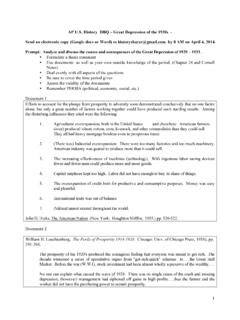Transcription of Chapter 33 The Great Depression and the New Deal,
1 Chapter 33 The Great Depression and the New Deal, 1933 1939 I. FDR: Politician in a Wheelchair Roosevelt s personality Formed by his struggle with infantile paralysis: Put additional steel into his soul Suffering humbled him to the level of common clay He schooled himself in patience, tolerance, compassion, and strength of will Another Great personal and political asset was his wife, Eleanor: Distant cousin of Franklin and his spouse Overcame the misery of an unhappy childhood Emerged as a champion of the dispossessed and, Ultimately the conscience of the New Deal. I. FDR: Politician in a Wheelchair (cont.) FDR s political career was as much hers as it was his own But Mrs. Roosevelt also marched to her own drummer She joined the Women s Trade Union League (see p. 645) and the League of Women Voters Moving into the White House, she brought an unprecedented number of women activists This network of reformers helped make her the most active First Lady in history She powerfully influenced the policies of the national gov.
2 Always she battled for the impoverished and the oppressed Sadly, her personnel relationship with her husband was rocky, due to his infidelities Condemned by conservatives and loved by liberals, she was one of the most controversial and consequential public figures of the twentieth century. I. FDR: Politician in a Wheelchair (cont.) Franklin Roosevelt s political appeal: The premier American orator of his generation As a popular Depression governor of New York: Sponsored heavy state spending to relieve human suffering Believed money, rather than humanity, was expendable Revealed a deep concern for the plight of the forgotten man Was assailed by the rich as a traitor to his class. I. FDR: Politician in a Wheelchair (cont.) Democratic National Convention (July 1932) Chicago: Speedily nominated Roosevelt Democratic platform: Promised a balanced budget Sweeping social reforms Flew to Chicago and personally accepted the nomination in person His words, I pledge you, I pledge myself to a new deal for the American people.
3 P752 II. Presidential Hopefuls of 1932 Roosevelt: Consistently preached a New Deal for the forgotten man, But he was annoyingly vague and somewhat contradictory Many of his speeches were ghost written by the Brains Trust (popularly the Brain Trust), A small group of reform-minded intellectuals A kitchen cabinet, who authored much of the New Deal legislation He rashly promised a balanced budget And berated heavy Hooverian deficits. II. Presidential Hopefuls of 1932 (cont.) Hoover: Remained in the White House: Conscientiously battling the Depression Out of the firing lines, his supporters halfheartedly assured half-listening voters Insisted that the Roosevelt s impending victory would plunged the nation deeper into the Depression With the campaign going badly for the Republicans, Hoover took to the stump Reaffirmed his faith in the American free enterprise and individual initiative.
4 P753 III. Hoover s Humiliation in 1932 Election of 1932: Hoover had been swept into office on the rising tide of prosperity He was swept out of office by the receding Depression Votes: 22,809,638 for Roosevelt; 15,758,901 for Hoover The electoral count 472 to 59 The loser carried only six rock-ribbed Republican states. III. Hoover s Humiliation in 1932 (cont.) Feature of the election: A distinct shift of blacks to the Roosevelt camp Victims of the Depression Shifted to the Democratic Party, especially in the Great urban centers of the North Hard times ruined the Republicans: It was as much anti-Hoover as it was pro-Roosevelt Democrats voiced a demand for change: a new deal rather than the New Deal III. Hoover s Humiliation in 1932 (cont.) Lame duck period: Hoover continued to be president for four long months, until March 4, 1933 Was helpless to embark upon any long-range policies without the cooperation of Roosevelt The victorious president-elect proved rather uncooperative Hoover arranged two meetings with Roosevelt In politics, the winner, not the loser, calls the tune.
5 III. Hoover s Humiliation in 1932 (cont.) Washington was deadlocked: The American economy clanked to a virtual halt One worker in four, unemployed Banks were locking their doors throughout Some Hooverites accused Roosevelt of deliber-ately permitting the Depression to worsen so he could emerge the more spectacularly as a savior. IV. FDR and the Three R s: Relief, Recovery, Reform Inauguration Day, March 4, 1933: Roosevelt denounced the money changers who had brought on the calamity Declared that the government must wage war on the Great Depression Moved decisively: Boldly declared a nationwide banking holiday, March 6-10 Summoned the Congress into special session to cope with the national emergency: IV. FDR and the Three R s: Relief, Recovery, Reform (cont.) Hundred Days (March 9-June 16, 1933): Congress cranked out unprecedented remedial legislation (see Table ) New measures to deal with the desperate economy It aimed at three R s: relief, recovery, and reform Short-range goals relief, and immediate recovery in two years Long-range goals permanent recovery and reform of current abuses IV.
6 FDR and the Three R s: Relief, Recovery, and Reform (cont.) Roosevelt s Hundred Days Congress: Willing to rubber stamp bills drafted by the White House Roosevelt s must legislation Gave him extraordinary blank-check powers Some of the laws passed expressly delegated legislative authority to the chief executive Passed many essential New Deal three R s though long-range measures were added later. IV. FDR and the Three R s: Relief, Recovery, and Reform (cont.) New Dealers: Embraced progressive ideas: Unemployment insurance, old-age insurance, Minimum-wage regulations, The conservation and development of natural resources, Restrictions on child labor. Invented some new schemes: Tennessee Valley Authority (see p. 765) No longer would America look as backward in the realm of social welfare as it once had.
7 P754 Table 33-1 p755 V. Roosevelt Manages the Money Banking chaos immediate action: Emergency Banking Relief Act of 1933: Invested the President with the power to regulate banking transactions and foreign exchange To reopen solvent banks Roosevelt turned to the radio: Delivered the first of 30 famous fireside chats Now safe to keep money in the reopened banks Confidence returned; banks unlocked their doors. V. Roosevelt Manages the Money (cont.) Glass-Steagall Banking Reform Act: Provided for the Federal Deposit Insurance Corporation: Insured individual deposits up to $5,000 (later raised) Ended bank failures, dating back to wildcat of Andrew Jackson (see Figure ). Melting good reserves: Ordered all private holdings of gold to be surrendered to the Treasury in exchange for paper currency Then took the nation off the gold standard Canceled the gold-payment clause in all contracts V.
8 Roosevelt Manages the Money (cont.) Authorized repayment in paper currency A managed currency was well on its way: His managed currency was inflation: Which he believed would relieve debtors burdens And stimulate new production Principal instrument for achieving inflation was gold buying He instructed the Treasury to purchase gold at increasing prices price of gold increased from $21 an ounce (1933) to $35 an ounce (1934) A price that held for four years V. Roosevelt Manages the Money (cont.) This policy did increase the amount of dollars in circulation Also, this inflationary result provoked the wrath of sound-money critics baloney dollar. The gold scheme came to an end in February 1934, when Roosevelt returned to a limited gold standard for international trade purposes.
9 (See p. 922) the United States pledged itself to pay foreign bills, if requested): In gold at the rate of one ounce of gold for every $35 due Domestic circulation of gold continued to be prohib- ited And gold coins became collector s items. p756 Figure 33-1 p756 VI. Creating Jobs for the Jobless Overwhelming unemployment: One out of four workers was jobless The highest level of unemployment in the nation s history Roosevelt had no hesitancy about using federal money to assist the unemployed At the same time to prime the pump of industrial recovery. Creating Jobs for the Jobless (cont.) Civilian Conservation Corps (CCC): The most popular of the New Deal alphabetical agencies Provided employment in fresh-air government camps for about 3 million uniformed young men They work was useful including reforestation Firefighting (47 lives lost), flood control, swamp drainage Recruits were required to help their parents by send- ing home most of their pay Both human and natural resources were conserved.
10 Creating Jobs for the Jobless (cont.) Critics of the CCC: Minor complaints of militarizing the nation s youth Charged that the CCC soldiers would later claim pensions for exposure to poison ivy Adult unemployment: Federal Emergency Relief Administration (FERA): Under Harry L. Hopkins Hopkins s agency granted $3 billion to states for direct dole payments or preferably for wages on work projects. Creating Jobs for the Jobless (cont.) Hard-pressed Special groups relief: Agricultural Adjustment Act (AAA): Made available millions to help farmers meet their mortgages Home Owners Loan Corporation (HOLC): Designed to refinance mortgages on nonfarm homes Assisted a million badly pinched households Not only bailed out mortgage-holding banks It bolted the political loyalties of relieved middle-class homeowners securely to the Democratic party.




